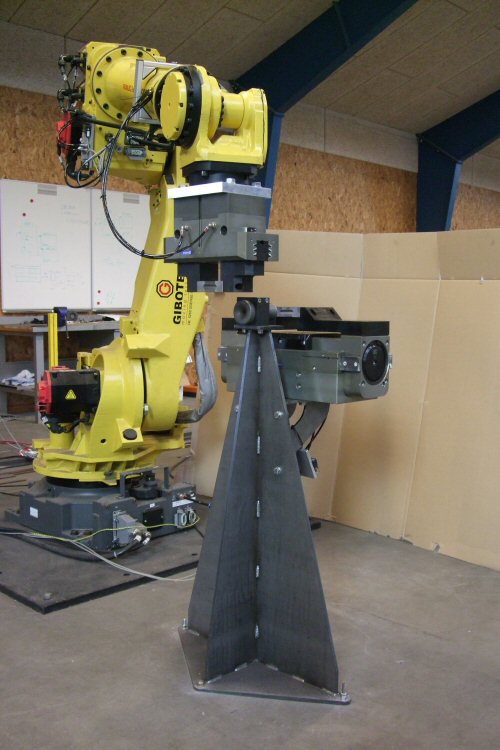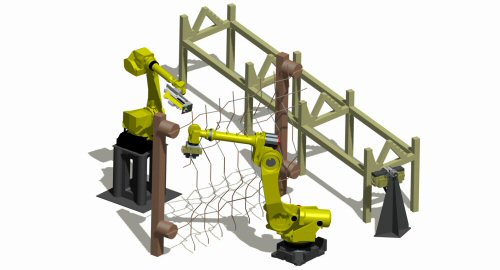Description of work
As the number of different processes involved in the production of tailor-made concrete structures is quite large, many types of production equipment are required. In order to be able to consider different processes in this work package, a robot has been chosen as the major automation equipment. With appropriate tools mounted, the robot can be used for many different processes.
The fact that a robot is very flexible can be exploited to the full in this type of project where the production is mainly one-of-a-kind. The planning and programming will be carried out off-line meaning that the equipment will be able to operate full-time.
The processes that have been chosen to consider include:
- milling for producing formwork
- production of non standard steel reinforcement involving
- bending of rebars
- handling/transportation of rebars
- binding (two rebars are to be bound together at the crossing point)
- spraying of release agent or coating.
Task 4.1 Selection and development of necessary tools and processing techniques for robots
Focus has been on production of steel reinforcement for uniquely shaped concrete elements. A test setup with a Fanuc R-2000iB robot has been established at Gibotech (DK).


Design of reinforcement production setup prototype.
Task 4.2 Process modeling
Processes considered:
- Milling. When a milling tool is mounted on the robot, the milling process causes an external force acting on the robot. This force causes robot deformation. A deformation model has been established and described in the paper: ‘A new Experimental Method for Predicting Static Displacements for Machining with Robot Manipulators’ by Jens Cortsen and Henrik G. Petersen. It was presented at the 2011 IEEE/ASME International Conference on Advanced Intelligent Mechatronics, Hungary, July 2011.
The size and direction of the 3D milling force is computed indirectly through the measurement of power used by the milling tool. A mathematical model that relates this power to the different types of milling forces has been verified and a compensation method has been established and verified. This work is described in the paper ’Advanced Off-line Simulation Framework with Deformation Compensation for High Speed Machining with Robot Manipulators’ by J. Cortsen and H.G. Petersen (submitted for publication at IEEE Advanced Intelligent Mechatronics (AIM) 2012). - Deflection of steel reinforcement bars. . As the rebar deflects due to gravity and forces from the robot when moving, a model of the deflection must be made. It means that we must be able to solve the dynamic equations describing the deflection of the rebar. These equations are the beam equation for elastic materials and suitable boundary conditions. Solving these equations during the simulation in Task 4.3 will be far too involved and time consuming, therefore a mathematical model describing the deflection is made in Task 4.3
- Spraying, see I. Lund, J. Cortsen and D. Sølvason. Development of a fully automated high-resolution mechanical spray patternator. International Advances in Pesticide Application, Aspects of applied Biology, 114, 2012.
Task 4.3 Framework for simulation based process optimization
SDU is currently designing and implementing the simulation framework based on the open source robotic framework RobWork (www.robwork.dk).
Activities related to steel reinforcement:
During the reinforcement production there is a large risk that the long rebars collide with the robot or the environment. To avoid this, the reinforcement production is planned offline using the simulation framework. The framework automatically ensures that collisions are avoided during the reinforcement production.
A dynamics engine (See Jimmy A. Jørgensen, Lars-Peter Ellekilde, and Henrik G. Petersen: RobWorkSim - an open simulator for sensor based grasping. In ISR/ROBOTIK 2010 - ISR 2010 (41st International Symposium on Robotics) and ROBOTIK 2010 (6th German Conference on Robotics). VDE-Verlag, June 2010) incorporated in RobWork is used in the framework for simulating the gravity impact on the reinforcement bars when bending the bars and to calculate the position for the robot hand. The relation between the mathematical model of the rebar deflection and the simulation model is described in the paper: J. Cortsen, J.A. Jørgensen, D. Sølvason and H.G. Petersen. Simulating Robot Handling of Large Scale Deformable Objects: Manufacturing of Unique Concrete Reinforcement Structures. IEEE Int. Conf. on Robotics and Automation (ICRA), St. Paul, USA, May 2012.
Activities related to the milling process:
In the planning of the milling tasks there are a number of potential problems to solve. It must be ensured that the robot does not collide with itself, the environment or the workpiece. Furthermore a compensation for the robot deformation must be made. These problems are solved offline by the simulation framework automatically ensuring collision avoidance and deformation compensation.
Task 4.4 Development of software to automatically plan robot paths
The aim of this task is to implement the robot path planning necessary to carry out the various robot tasks described in the framework from Task 4.3.
WP leader: University of Southern Denmark
